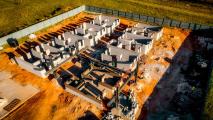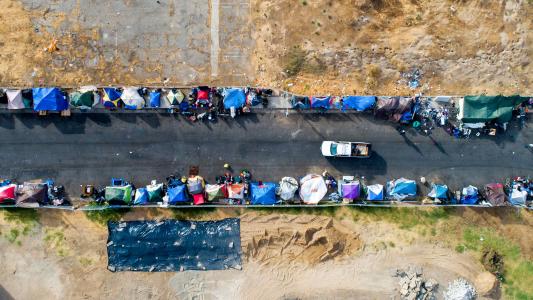A warehouse in frigid Minnesota is being transformed into a new kind of homeless shelter, one where residents aren’t just given a bed, but their own tiny home.
This new tiny house village is designed to overcome the limitations of traditional homeless shelters, while also addressing the unique problems of sheltering people during a pandemic.
Homeless Shelters: Pros and Cons
Shelters can play a pivotal role in the lives of homeless people.
In the short-term, they can deliver protection from the elements. Looking further ahead, they can provide access to social workers, housing support, job training programs, and other services that can help homeless people move into permanent housing.
But there are tradeoffs to staying in a shelter that some people aren’t willing to make.
Many shelters feature communal sleeping arrangements, with dozens of beds packed into a single room. That means those sleeping in the facilities have very little privacy and little security for belongings.
The close quarters of homeless shelters can be particularly inhospitable to people with mental health disorders, and they also make it easier for infectious diseases to spread — a major concern in the midst of a pandemic.
It Takes a Tiny House Village
In an effort to get more homeless people off the streets and into shelters, Minneapolis nonprofit Avivo is spearheading a two-year pilot project called Avivo Village.
The tiny house village consists of many small buildings, all nestled within the walls of an empty publishing warehouse. The buildings are divided into four, six, or eight dwellings, each with 70 square feet of space.
Every dwelling contains a bed, desk, shelf, and window, as well as its own air vent. Perhaps most importantly, each dwelling has its own door that can be locked from the inside.
“A resident can leave their tiny house knowing their belongings are safe and secure,” according to Avivo’s website.
Residents of the tiny house village have access to showers and bathrooms, as well as free washing machines and dryers. There are also common spaces with enough room for social distancing.
Free, prepackaged meals are available to residents, and if they have pets, those animals are welcome to live with them.
The building has a secured entrance and staff — resident advocates, mental health professionals, and housing case managers — on site all at times.
When in common areas, all staff members and residents are required to wear masks to prevent the spread of COVID-19. Avivo also has a strict sanitizing schedule and offers COVID-19 testing in the village.
A Bridge, Not a Destination
The idea of sheltering homeless people in tiny house villages isn’t brand new — California, Washington, and several other states have outdoor versions of the Avivo model, and some have been around for more than a decade.
However, the pandemic has increased interest in the model, and now Avivo is demonstrating what can be done with it indoors — an approach that could make the homes easier to keep secure and climate-controlled.
The two-year Avivo Village project costs an estimated $8 million.
According to the Star Tribune, Hennepin County is contributing $2.2 million for its construction, while the city of Minneapolis and the state of Minnesota are providing $4 million to fund operations. Private sources are covering the cost of services, such as mental health care.
In December, the first 16 residents moved into the tiny house village, and starting on March 8, it’ll be fully operational, providing 100 homeless people with their own indoor living space.
Housing is what ends homelessness, not shelters.
David Hewitt
Each resident was referred to Avivo Village by local street outreach workers, and, while there’s no set time limit on how long they can stay, the goal is to help them move into permanent housing within 90 days.
How close Avivo comes to meeting that goal will help determine the success of the pilot program.
“Shelters need to play that critical role of being a place that people can stay safely and feel supported, but supported to get out into housing,” David Hewitt, director of Hennepin County’s Office to End Homelessness, told the Star Tribune.
“Housing is what ends homelessness, not shelters.”
Editor’s Note, 3/3/21, 11:35 AM ET: This article was updated to clarify the types of facilities available to Avivo Village residents.
We’d love to hear from you! If you have a comment about this article or if you have a tip for a future Freethink story, please email us at [email protected].






